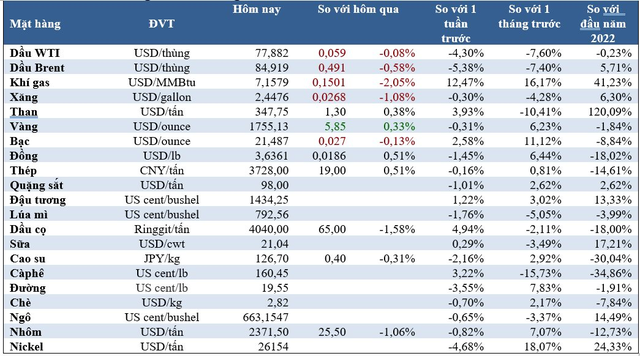Oil prices fluctuate slightly
Brent fell while US WTI rose slightly, but only slightly above two-month lows as G7-proposed limits on Russian oil prices cast doubt on how to limit supplies oil supply from Russia of this measure.
Information from a European official on Wednesday said that the G7 nations are considering limiting the price of Russian seaborne oil in the range of $65-70 per barrel. This price is said to be higher than the price of oil that Russia is trading.
A higher-than-expected increase in US gasoline inventories and China’s expansion of COVID-19 control also added downward pressure on crude oil prices.
Brent crude ended the session down 29 cents, or 0.3%, at $85.12 a barrel, while US West Texas Intermediate (WTI) rose 2 cents to $77.96.
The trading volume in this session is low due to the Thanksgiving holiday in the US.
Gold rises on weak USD
Gold prices rose to the highest level in nearly a week as the dollar weakened, after minutes of the US Federal Reserve’s November meeting signaled that it may soon slow down the pace of interest rate hikes.
Spot gold rose 0.3 percent to $1,754.13 an ounce, while December gold futures rose 0.5 percent to $1,754.30.
Minutes of the Fed’s November 1-2 policy meeting released on Wednesday showed “a substantial majority” of Fed policymakers agree that “it may soon be the right time.” to slow down the rate of interest rate increase.
The Dollar index was 0.2% lower, making bullion cheaper for overseas buyers.
Copper price increases
Copper prices rose on Wednesday, supported by a weaker dollar, optimism that US interest rate hikes will slow and China’s support for its real estate sector.
Three-month copper futures on the London Metal Exchange (LME) rose 0.5% to $8,044.50 a tonne.
There are already signs that the Fed will pivot to policy, so concerns about the risk of a recession are easing. The Fed minutes seem to reinforce that pivot.”
The dollar index slid to its lowest level in more than a week, making the metal cheaper for non-dollar holders.
Prices also rose on news that China’s largest commercial banks have pledged to grant at least $162 billion in new credit to property developers in a concerted effort to support the industry. this area.
Robusta coffee increases
Robusta coffee futures on the ICE exchange rose in quiet trading on Thursday amid news of slowing supply in Vietnam. Robusta coffee futures for January delivery closed up 1.6 percent to $1,843 per tonne.
Traders said the supply of new robusa beans from the world’s top producer Vietnam has slowed as scattered rains in the region disrupted the picking and drying process.
There was no price of Arabian coffee in the last session due to the Thanksgiving holiday in the US coffee market.
Palm oil declines
Malaysian palm oil prices fell on Thursday, ending a three-day rally, as the ringgit rallied its most in more than six years as the political deadlock ended, sparking some profit-taking.
Palm oil for February delivery on the Bursa Malaysia Derivatives Exchange lost 1.44%, ending afternoon trade at 4,046 ringgit ($901.11) a tonne, erasing a 6.74% gain. in the previous three sessions.
At the start of the session, the contract rose as much as 2.80%, hitting a near two-week high on solid exports and expectations of lower output.
Electricity increased
Spot electricity prices in Europe rose on Thursday as wind power supplies are forecast to decline across the region, but the gains are modest as demand in Germany is expected to decline.
German electricity prices for delivery on Friday rose 2.5% to 248 euros ($258.42) per megawatt hour (MWh); France’s electricity price increased 2.9% to 251 euros/MWh.
Refinitiv Eikon data shows that daily wind power production in Germany is forecast to fall by 2.4 gigawatts (GW) to 12 GW on Friday, while in France a fall of 4.3 GW is expected to 5. ,7 GW.
Reduced rubber
Rubber futures prices on the Japanese market fell on Thursday, while prices in Shanghai also fell due to an increase in the number of COVID-19 infections in the world’s top rubber buyer – China – and the activity Weak domestic production affects demand psychology.
Rubber contract for April delivery of the Osaka Exchange ended the session down 0.6 yen, or 0.3%, to 214.6 yen ($1.55)/kg.
Rubber contracts for January delivery on the Shanghai exchange fell 30 yuan to 12,755 yuan ($1,786.21) per tonne.
Rice prices increase
Vietnam’s export rice prices this week hit their highest levels since July 2021 as traders expect reduced supply as well as increased demand for the grain to support prices later in the year.
Vietnam’s 5% broken rice price was offered at $438/ton (FOB), compared with $425-430 last week.
The price of 5% broken parboiled rice of the world’s top exporter – India – this week was unchanged at 373-378 USD/ton amid good demand from importing countries.
Thailand’s 5% broken rice price is listed at $419-425/ton, compared with $410-425 last week.
Iron ore rose
Iron ore prices ended a three-day losing streak, reversing gains on Thursday as recent supportive measures for China’s real estate sector overshadowed concerns about a spike in COVID-19 cases in the region. recently.
January iron ore on China’s Dalian Commodity Exchange ended trading up 1.3% to 732.0 yuan ($102.36) a tonne.
On the Singapore Exchange, iron ore was up 0.6 percent at $95.90 a tonne.
Prices of some key items in the morning of November 25:

